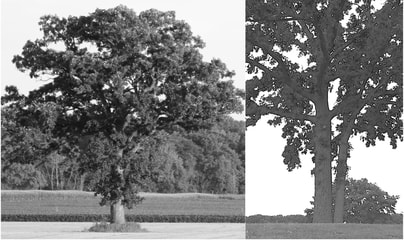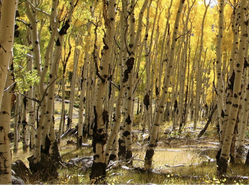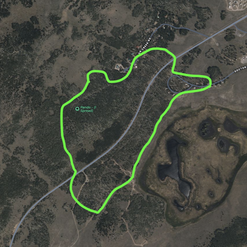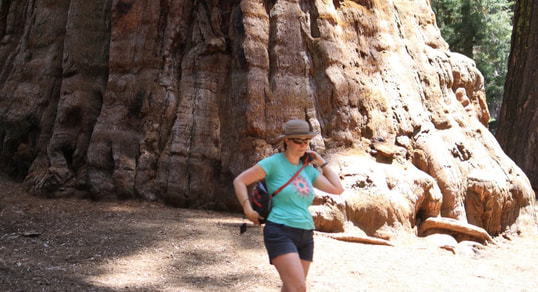 left: solitary oak with a single trunk. right: double trunk tree, which are actually two seperate trees growing next to each other. left: solitary oak with a single trunk. right: double trunk tree, which are actually two seperate trees growing next to each other. There are notable trees around the world that draw people’s attention for historic reasons or because they are sizeable. Old trees are respected as they can live for centuries and even millennia, providing us a connection to our ancestors. Some of us are drawn to the tallest and largest tree of a particular species. We might be interested in knowing which tree is the oldest, the tallest, or the largest in the world. These may seem like simple questions with straight-forward answers, but we do need to dig a little deeper when looking for the answers. What is a Tree When you think of a tree, do you picture a tree with a single trunk that divides into larger branches forming the crown? Some trees appear to have a couple trunks emerging from the same point at the ground. Trees like this could be the same tree or possibly different trees that are growing immediately next to each other. If you are interested in measuring the tree, you’d obviously need to determine if it is in fact a single tree. Most trees we come across are individual trees with a single trunk. This is the form of the trees we usually have in mind when talking about the oldest tree, tallest tree, and largest tree. Oldest, Tallest, Largest The oldest known trees are Great Basin bristlecone pines. One of these trees known as Methuselah, grows in the White Mountains in California and has been aged over 4,850 years. This tree is often recognized as the oldest tree in the world, yet there is another one nearby that has been estimated to over 5,070 years. Stay tuned as an alerce tree in Chile was estimated last year as close to 5,400 years old (Is This the Oldest Tree in the World - LiveScience). Regardless of which one is truly the oldest, all three of these trees are remarkable beings that have survived for 5 millennia. The tallest known tree in the world is a coastal redwood known as Hyperion, measured at over 380 feet in height. Coastal redwoods grow along the Pacific coast of northern California into southern Oregon. While the tallest tree measurement focuses solely on the height of the tree, when looking for the largest tree, we are looking at total volume of the tree (which brings in height as well as width of the tree's trunk, branches, etc.). The General Sherman Tree, a giant sequoia in Sequoia National Park, is currently the largest known tree in the world. To qualify, this title of largest tree is in relation to the measured volume of its trunk and crown. The amount of space this individual takes up is impressive, standing roughly 275 feet tall and its trunk measuring over 36 feet wide at the base. To give perspective of the size of The General Sherman Tree, the climbing area we flag off under our climbing trees is often 35-40 feet wide. Likewise, most of our climbing trees are 65-70 feet tall; which at that same height above ground, The General Sherman Tree's trunk is still about 15 feet wide. It is an impressive tree, but could there really be a tree larger than that?  aspen stand - nationalforest.org aspen stand - nationalforest.org The Tree is the Forest All the trees mentioned so far are single-stem species; also referred to as non-clonal. Looking underground, you can view these trees as a root system that gives rise to a single trunk. Again, there are instances where another stem or stems my arise, but they originate from the same general point of the root system. These new sprouts/stems/trunks can lead to a multi-stemmed tree whose life continues even after the original trunk dies off. This is a phenomenal characteristic that can extend the tree’s existence. Clonal species, in comparison, send up multiple stems/trunks from the same root system, but at different locations along the root system. Above ground you might see several trees or individual trunks growing in an area. While it might appear that you are standing in a grove or grouping of different trees, they are in fact all part of the same tree. One large root system with multiple trunks. One tree. When we bring clonal species into the mix, it's no longer a straightforward answer to the question of what’s the largest or oldest tree!  approximate outline of the outer edge of Pando's spread in Utah approximate outline of the outer edge of Pando's spread in Utah Meet Pando Quaking aspens are one of the more widely known clonal trees that you may be familiar with. As with many clonal tree species, a single quaking aspen tree can have 100’s-1,000’s of trunks all generated from the same root system. While one of its individual stems may not be all that impressive in terms of the thickness of trunk or height, the overall spread of the tree can reach out over acres. It may leave you wondering, can a clonal tree's many smaller stems even come close to measuring up against the total volume of the massive giant sequoia? Pando, meaning “I spread” in Latin, is a quaking aspen in south central Utah. This organism’s root system has over 47,000 stems/trunks and spreads out just over 100 acres. It grows across an area about the size of 80 NFL football fields! The volume in all of Pando’s trunks and crowns exceeds that of The General Sherman Tree. Now who’s the largest tree? You may not see that as an apple-to-apple comparison, but hopefully it puts things in perspective. I am truly impressed by the size of both trees. Standing in the midst of a humongous clonal tree like Pando or at the base of The General Sherman Tree, I feel infinitesimal. Both are the largest known trees in the world; one the clonal giant, one the single-trunk giant. You’re Only as Old as You Feel
Clonal species continue growing and generating new stems while older stems are dying off. This can result in the tree living far longer than any single stem. Aging trees can be difficult, particularly when you are dealing with a clonal species like quaking aspen. The trunks decay relatively quickly after dying, therefore aging relies on methods beyond counting growth rings or measuring trunk diameter. At the oldest end of the range, Pando most likely germinated after the last glacial period in the area. Scientists who study quaking aspen, estimate Pando’s age somewhere between 8,000 and 12,000 years old. Does that make Methuselah and its unnamed neighbor feel young? I am in complete reverence standing in the presence of any of these trees. Regardless of how deep I like to dive into any one tree or metric, I appreciate the ambiguities that arise from the seemingly simple question like, what is the largest tree? Look For Yourself Big tree hunters are in constant search of the oldest, tallest, and largest trees. Some will travel the world on this quest. Others may focus their efforts on the trees within their state or on a specific tree species. Whatever metric you are drawn to, there are many noteworthy trees in each county, state, and region. If you are amazed by the age of Pando, I encourage to look into Old Tjikko in Sweden and the wollemi pine in Australia. If height impresses you, maybe read up on tuliptree as it is the tallest known native deciduous tree species in North America. The Montello Cottonwood is a Wisconsin tree worthy of a visit as the tallest known tree in the state. If you admire overall size of a tree, the largest known bur oak growing in Wisconsin is at Stone Fences Farm in Dousman.
0 Comments
|
AuthorAs a G.O.T.C. Recognized Master Instructor & Facilitator, I.S.A. Board Certified Master Arborist, and T.C.I.A. Certified Treecare Safety Professional, Curt has spent over 30 years dedicated to the study and care of trees. Categories
All
Archives
May 2024
|
|


 RSS Feed
RSS Feed
